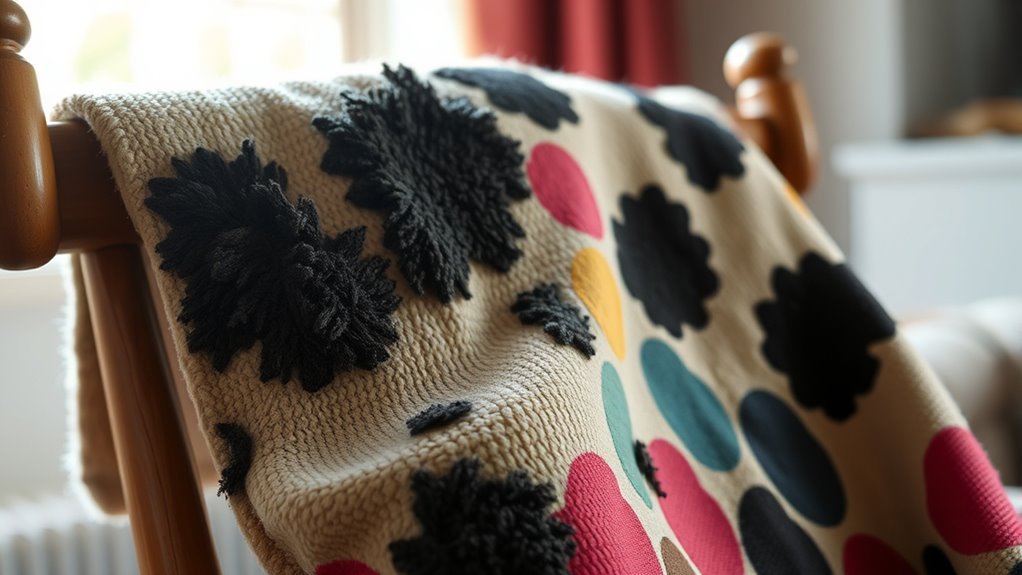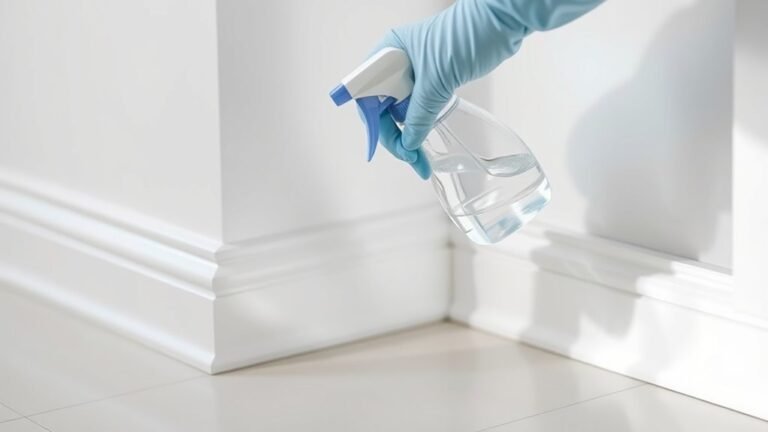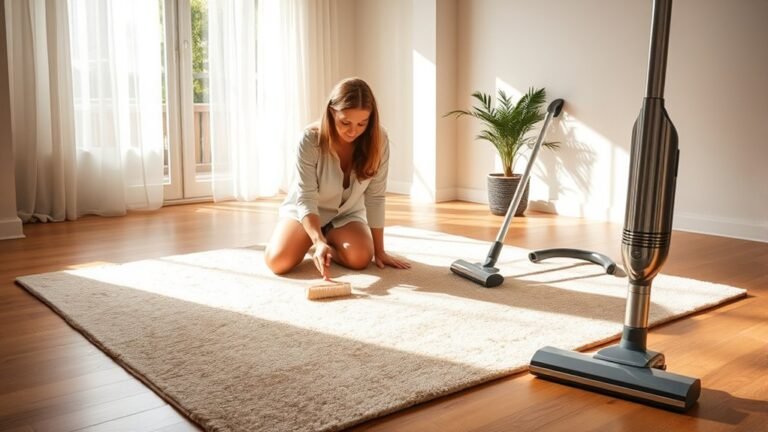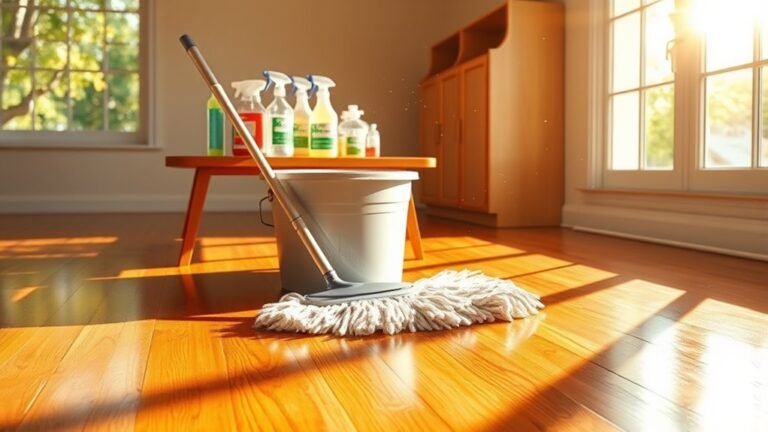How to Remove Mold From Blanket
If you find mold on your blanket, first take it outside to brush off loose spores. Next, pre-treat the area with white vinegar or a mold cleaner and wash it in warm water using a long cycle with an extra rinse. Dry your blanket thoroughly in sunlight or a well-ventilated space to prevent mold from returning. Always wear gloves and a mask to protect yourself. Want to know how to keep your blankets mold-free long term?
Identifying Mold on Your Blanket

Mold on your blanket usually shows up as dark spots or patches that feel damp or musty. You’ll notice it more on natural blanket materials like cotton or wool, which hold moisture longer, but synthetic fibers aren’t immune either. Different mold types can appear in various colors—black, green, or even white—and each thrives in damp, poorly ventilated conditions. Knowing the mold type helps you decide how to tackle it, but your first step is spotting those telltale signs. If your blanket smells off or has visible discoloration, it’s time to act. Don’t ignore these warning signs if you want to keep your space free and fresh. Recognizing mold early means you can reclaim your freedom from musty, contaminated bedding quickly.
Preparing Your Workspace for Cleaning
Before you start cleaning, set up your workspace to protect both yourself and your surroundings. Good workspace organization means having your cleaning tools ready and a clear area to work in. Choose a well-ventilated space, preferably outdoors or near an open window, to avoid spreading mold spores indoors. Lay down old towels or plastic sheets to catch any debris or moisture from your blanket.
| Workspace Element | Purpose | Examples |
|---|---|---|
| Ventilation | Prevent mold spread | Open windows, fans |
| Protective Covering | Catch debris and moisture | Towels, plastic sheets |
| Cleaning Tools | Efficient mold removal | Brushes, gloves, sprays |
| Clear Workspace | Avoid contamination | Remove clutter |
Organizing your workspace this way frees you to clean effectively and confidently.
Essential Safety Precautions to Take

Although it might seem straightforward, taking essential safety precautions is important when removing mold from your blanket to protect your health and prevent further contamination. Mold exposure can cause respiratory issues, allergic reactions, or skin irritation, so it’s critical you don’t underestimate the risks. Before you start, gear up with proper safety gear—wear gloves, a mask, and eye protection to minimize contact and inhalation of mold spores. Work in a well-ventilated area to help disperse airborne spores and avoid spreading mold to other parts of your home. Also, avoid touching your face or rubbing your eyes during the process. By taking these precautions, you’ll keep yourself safe and guarantee the mold removal process is effective and thorough.
Gathering Cleaning Supplies and Materials
You’ll need a few key supplies to effectively remove mold from your blanket. Gathering the right cleaning tools and cleaning agents empowers you to take control and restore your blanket’s freshness. Here’s what you should have on hand:
- Rubber gloves to protect your skin
- A soft brush or cloth for gentle scrubbing
- White vinegar or a mold-specific cleaning agent
- Baking soda to neutralize odors and aid cleaning
- A spray bottle for easy application of solutions
Having these essentials ready lets you tackle mold confidently and freely without unnecessary stops. With the right materials, you’re equipped to reclaim your blanket’s comfort and cleanliness on your terms.
Pre-Treatment Steps for Mold Removal

Since mold can deeply penetrate fabric fibers, treating your blanket properly before washing is key to preventing stains and lingering odors. First, identify the mold types affecting your blanket—some molds are more stubborn and require stronger treatment. Next, check your blanket materials; delicate fabrics like wool or silk need gentler care compared to cotton or synthetics. Start by taking your blanket outside and brushing off as much mold as possible to avoid spreading spores indoors. Then, prepare a pre-treatment solution suitable for your blanket’s fabric—usually a mix of mild detergent and white vinegar works well against many mold types. Apply this solution to the affected areas and let it sit for 15-30 minutes. This step loosens mold and prepares your blanket for a thorough wash, freeing you from stubborn mold residues.
Washing Techniques for Moldy Blankets
Before tossing your blanket in the wash, you’ll want to apply the right pre-treatment methods to tackle mold effectively. Choosing the ideal washing settings, like water temperature and cycle type, is key to fully removing mold spores. Let’s look at how these steps work together to restore your blanket.
Pre-treatment Methods
Although mold can be stubborn, treating your blanket properly before washing can make a big difference in removing it effectively. Different mold types and blanket materials need specific care to avoid damage and guarantee thorough cleaning. Here’s how you can pre-treat your moldy blanket:
- Brush off loose mold outdoors to avoid spreading spores inside.
- Apply a vinegar solution to kill most mold types naturally.
- Spot-treat stains with baking soda paste for gentle abrasion.
- Use a mold-specific enzyme cleaner if the fabric allows.
- Let the pre-treatment sit for at least 30 minutes to break down mold colonies.
Optimal Washing Settings
When washing a moldy blanket, choosing the right settings is essential to guarantee mold removal without damaging the fabric. Start by selecting the ideal temperature—warm water usually works best to kill mold spores without shrinking or weakening the fibers. Avoid hot water unless the care label specifically allows it. Next, pick a longer washing cycle; this gives detergent and water more time to break down mold and eliminate odors. If your machine has a heavy-duty or allergen cycle, those can be great choices. Also, use an extra rinse cycle to make sure all residues are washed away. By dialing in these settings, you can confidently clean your blanket, freeing it from mold while preserving its comfort and longevity.
Natural Remedies to Combat Mold
If you want to tackle mold on your blanket without harsh chemicals, natural remedies offer effective and safe alternatives. These natural solutions harness effective ingredients found in your kitchen or garden, letting you reclaim your space freely and healthily.
Try these simple, powerful options:
- White vinegar: Its acidity kills mold spores effectively.
- Baking soda: Absorbs moisture and deodorizes your blanket.
- Tea tree oil: A natural antifungal that prevents regrowth.
- Lemon juice: Contains natural acids to break down mold.
- Sunlight: UV rays naturally disinfect and dry your blanket thoroughly.
Using these remedies, you maintain control over what touches your blanket, avoiding harsh chemicals and embracing freedom through nature’s own mold-fighting power.
Using Commercial Mold Removal Products
One of the quickest ways to tackle mold on your blanket is by using commercial mold removal products designed specifically for fabrics. These commercial products are formulated to break down mold spores effectively while being safe on delicate materials. When you choose a product, look for one that clearly states its mold removal capabilities and fabric safety. Always test it on a small, hidden area first to avoid damage. Apply the product following the instructions, usually involving spraying or soaking the affected area and letting it sit for a designated time. After treatment, rinse thoroughly to remove any residue that could irritate your skin or attract more mold. Using commercial products gives you a fast, reliable way to reclaim your blanket and enjoy your freedom from mold.
Drying and Airing Out Your Blanket Properly
After treating your blanket with mold removal products, the next step is to dry and air it out properly to prevent mold from returning. Proper drying and ventilation are key to maintaining freedom from mold’s grip. Here’s how you can do it effectively:
Properly drying and ventilating your blanket after mold treatment is essential to keep mold from coming back.
- Hang your blanket outdoors where it can get direct sunlight exposure; sunlight naturally kills mold spores.
- Choose a breezy spot to promote airflow and speed up drying.
- Avoid damp or shaded areas that trap moisture.
- Maintain moisture control by fully drying the blanket before storing it.
- If drying indoors, use a dehumidifier or fan to reduce humidity levels.
Preventing Mold Growth in the Future
Though you’ve removed the mold and dried your blanket thoroughly, you’ll want to take steps to prevent it from coming back. First, consider investing in mold resistant fabrics when replacing or buying new blankets—they naturally inhibit mold growth, giving you more freedom from worry. Keep moisture control top of mind by storing your blankets in dry, well-ventilated spaces. Avoid leaving them in damp basements or closets where humidity lingers. Use dehumidifiers or moisture absorbers if needed, especially in humid climates. Regularly airing out your blankets in sunlight also helps keep mold at bay. By combining mold resistant fabrics with good moisture control habits, you’ll enjoy a fresh, mold-free blanket that lets you relax without restrictions or concerns.
Frequently Asked Questions
Can Mold on Blankets Cause Health Issues?
Yes, mold on blankets can definitely cause health risks, especially if you have mold allergies. When you come into contact with mold spores, it can trigger allergic reactions like sneezing, itching, or even respiratory issues. If you value your freedom to live comfortably, it’s important to keep your blankets mold-free to avoid these problems. Taking care of your environment helps you stay healthy and enjoy life without unnecessary health concerns.
Is It Safe to Use Bleach on All Blanket Types?
You shouldn’t use bleach on all blanket types because it can damage delicate fabrics or cause colors to fade. Instead, check the fabric care label first to see if bleach is safe. If it’s not, try bleach alternatives like white vinegar or baking soda—they’re gentler and still effective. Sticking to proper fabric care lets you keep your blankets fresh without risking harm, giving you freedom to enjoy comfort without worry.
How Long Does Mold Take to Grow on a Blanket?
Mold growth can start on a blanket within 24 to 48 hours if it’s damp and kept in a warm, humid spot. To keep your freedom from pesky mold, you’ll want to use prevention methods like thoroughly drying your blanket after use and storing it in a well-ventilated area. By staying ahead with these simple steps, you’ll enjoy fresh, mold-free blankets and avoid any unwanted restrictions on your comfort and style.
Can Mold Spores Spread to Other Household Items?
Yes, mold spores can definitely spread to other household items if you’re not careful. To keep your space fresh and free, you’ll want to follow some solid mold prevention tips like regularly airing out rooms and controlling humidity. Don’t forget household cleaning routines—wipe down surfaces and wash fabrics frequently. Taking these simple steps helps you enjoy a cleaner, freer home without mold creeping in and ruining your vibe.
Should I Discard a Heavily Moldy Blanket?
Ever wonder when mold removal just isn’t worth the effort? If your blanket is heavily moldy, it’s often safer to discard it rather than risk spreading spores throughout your space. While you might want to save it for blanket care, severe mold can cause health issues and damage fibers beyond repair. Choosing freedom from mold means knowing when to let go and keep your home fresh and safe.






